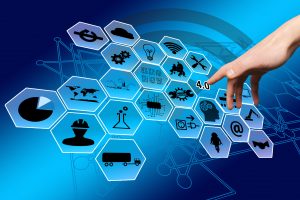
This white paper gives a brief view of the 5G services and explains how utility companies can get benefited by using these new 5G services in their day to day operations.
1. Introduction
The Utility companies (or) utilities fulfill the needs of modern societies to sustain a healthy and happier life by providing various services such as water supply, electric supply, waste management, gas supply, etc. All the utility companies rely on the modern telecom systems/telecom services provider to effectively deliver the services to the customers and cost-effectively run the business. Each generation in the Telecommunication space brought in more and more advantages to utility providers. The 5th Generation telecommunication network brings revolutionary changes to the utility service sector than any of the ancestor technologies brought in.
The aim of the first three-generation mobile phone technologies was to deliver the voice services and all these networks were built on the foundation of Circuit-switched telephone network. The fourth-generation systems were built on IP Protocols and allows the network to deliver high-speed data experience to its customers.Unlike the previous generations that were built for delivering voice and data service, 5G is focused to deliver all communication services that required to build different use cases like smart cities, smart grids, etc.
5G Brings exceptional capabilities that help utility companies to manage their services better and opens new opportunity to collaborate with the mobile network operator to share the resources.
2. Telecom Service used by utilities before 5G
Before the arrival of 4G and Narrowband IoT the utilities were using the telecom services for effective communication between the employees and customers. The advanced communication services such as ‘Push-to-Talk’ , ‘Conference calls’, etc helps utility companies to get connected with the employees who work on the field and help them to operate and manage their services efficiently. The faster internet provided by 4G allows the consumers to use more data and Utility companies were able to collect the monthly rentals, complaints and customer interactions using their own web-based/mobile-based applications. This reduced the operation cost of the Utilities and allowed Utility companies to effectively manage their subscribers as well.
Below Listed are the few areas in which utilities use telecom services before 5G.

Figure 1
3. Maintenance and Management of Production and Supply systems
To complete the daily maintenance and monitoring tasks of the production systems and supply lines utilities rely on advanced telecommunication communication technologies such as push to talk, smart metering, etc.
3.1. Push To Talk
The push to talk technology and services are widely used by utility company employees. The PTT helps the employees to coordinate between a group of people involved in similar tasks. The PTT services are easy to activate from a single switch or click and helps the employee to focus on the work.
3.2. Smart Metering and Monitoring of Devices
The SMS services provided by the telecommunication network helped the utility to monitor their system up to an extent. The fault Management systems with SMS facility are able to initiate SMS in case of faults and helps utilities to take preventive actions faster.
3.3. Private LTE networks
Private LTE networks are designed to work on a specific area or to serve a specific business such as power plants, treatment plants, etc. This private network allows utilities to get a dedicated network for internal communication in a specific area. Also, it helps the utilities to realize the industrial automation process in the specific areas such as production units, power generation plants, etc which required a dedicated networks to exchange large amounts of data.
4. Consumer Management
The era of 4G changes the way in which utilities manage their customer services. The 4G brings fast internet to everyone’s mobile phone which made the customer interactions easier for utilities. Through mobile applications, utilities able to handles the following effectively and reduce operating cost by nearly 10 to 20%.
- Payment management.
- Customer Registration and address change requests.
- Compliant registration and status of the resolutions.
5. 5G Technology and Utilities
5G is the Fifth Generation mobile network technology followed by 4G, has more data transfer speed, less latency and has the capability to accommodate more connected devices in an area. 5G has introduced new cellular radio technology known as 5G NR along with combination of various radio technologies with the goal of achieving machine to machine communication involving less human intervention, where the data transfers in Gbps within seconds of time. 5G also brings in new services such as Embb, URLLC, MMTC and network slicing which aims to increase efficiency and automating day to day operations for the utilities.
5.1. How new 5G services are helping Utilities
The new services and features of 5G uplifts the industrial automation and machine to machine communications to the next level. Following are the new services offered by 5G to utilities.
5.1.1. Enhanced Mobile Broad Band: Embb
5G provides an exceptional data transfer rate. The data transfer rate of a typical 5G network varies from 2-10 Gbps. This high data transfer rate enables the user to access UltraHD and 360-degree videos from anywhere. It also allows the subscribers to use AR and VR features even from highly populated areas and also from fast-moving objects. This helps the utilities to realize,
- The remote maintenance and monitoring of the equipment without frequent site visits.
- Surveying the site for new production and supply chain using the drones
- Transfers more data to cloud environment rather than maintaining them locally.
5.1.2. Ultra-Reliable Low Latency Communication: uRLLC
In 5G the latency of the communication has reduced to 1ms or even less. This allows real-time communication between machines to machines and machines to humans and helps utilities to brings industrial automation and intelligent transport etc. into service.
5.1.3. Massive Machine Type Communication: mMTC
Massive machine Type communication services had been realized by LPWA (Low Power Wide Area) and NB-IoT (Narrow Band Internet Of Things) Technologies. These technologies work together with the new 5G core network thus the 5G network deliver higher bandwidth and ultra-low latency communication to many devices in an area. This feature of the 5G brings more and more connected devices and helps the utility to setup smart meters and smart sensors everywhere in their production and service areas.
5.1.4. Network Slices
5G introduces a new concept in the network called network slicing which allows the operator to create different logically separated networks parallel on the same physical infrastructure. Each of these logical networks will be built to meet the requirement of a specific service or application. Telecom operators can create slices for any organization based on their specific requirements and lease these slices. The network slicing helps the utilities to create a private network for the company’s day-today operation and for other advanced operations in a telecom service provider’s network and avoid the burden of managing private network by themselves.
6. 5G use cases for utilities
The new features and services of 5G bring increased data transfer speed and more and more connected devices in an area. This helps utilities to transfer more and tasks from the world of humans to smart connected devices and machines which can transfer huge amounts of data in a very short time and take real-time decisions based on this data. This enables various use cases for utilities.
6.1. Smart Grids
A smart grid is composed of different energy sources mainly renewal energy sources in large and small scales, smart meters to measure the utilization and production of energy in different sources and smart appliances to maintain the stability of the production and supply lines. The smart grids mainly depend on the small power producers for power production. So,monitoring the power production and power utilization is equally important to maintain a reliable system.
The 5G technology will helps the smart Grids to connect almost every device in the grids with each other and also collect the real-time data from each of these devices to a centralized intelligent data server. This provides accurate monitoring of each and every equipment and key performance indicators in the network and provides the following advantages
- Helps intelligent systems to predict failures and outages thus helps the utilities to reduce downtime.
- Forecast the energy load and peak energy usage of a particular area at given point of time.
- Increase or decrease the power generation automatically and also distribute power effectively to an area.
6.2. Advanced Metering and Monitoring solutions
The advanced metering solution includes smart meters connected to management systems via the telecommunication networks. The primary aim of the smart meters before the 5G was to communicate the usage of a service to a centralized server. Since the number of devices that can support by older telecom technologies was less the number of meters and sensors that can be kept in an area was also limited.
5G uplifts these metering solutions to the next level where the smart meters and sensors monitor all the variables of utility service. These variables include water quality, temperate, pressure, toxic gases, etc. The 5G infrastructure allows the utility to have sensors and meters even in the remote production areas, underground pipelines, and even in deeper mining areas. The less energy usage of 5G will help the sensors to be in services for more than 10 years without charging and replacement and this reduces the cost of maintaining the metering solutions. The low latency communications channel provides by 5G helps the utilities to act on these meter reading and sensor data in real-time and avoids catastrophic events that harm the production and supply chain.
The advanced metering and monitoring solutions in 5G Brings the following advantages:
- Remotely measure the usage of utility and bills for all subscribers even the subscribers in the remote areas.
- Connect and disconnect the services to subscribers remotely.
- Identify the outages and issues in the network much faster.
6.3. Remote Equipment Monitoring and Maintenance
The distinct capabilities of 5G allows the utilities to monitor their equipment anywhere in the production or supply chain from a remote operation center using high definition cameras, UAVs and robotic hands, etc.
The Network slicing feature of 5G facilitates utilities to have a dedicated network according to utility requirements. The utilities can lease or purchase a dedicated network slice of 5G which has higher bandwidth and low latency and use it for remote monitoring and maintenance. The higher bandwidth helps the utility to keep HD cameras near all the equipment to monitor them in real-time. The autonomous vehicles and monitoring devices that can be controlled by the 5G network help the utility to inspect their remote production and supply chain periodically from a remote operation center in real-time. If robot arms and necessary tools can set up in UAV then employees can be in the operation center and complete the task that required a human intervention remotely. This reduces the maintenance cost and time required to repair faulty equipment in a remote area. More importantly, the remote equipment monitoring and maintenance using 5G help the utility to reduce the risk of human presence in a hazardous environment for equipment monitoring and maintenance.
6.4. Digital Data Management and Subscriber Management
The 5G brings in more and more connected devices. As these devices generate more data and it becomes important to Maintain and Manage this data securely. The data that belongs to critical operations such as UAV, or Robotic arms and automatic factories, etc. needs to be processed locally to avoid delays in operations. The Mobile Edge Computing technology of by 5G helps the utilities to save and process the data belongs to an area or specific type locally. This reduces the latency in transferring the data to remote servers and also helps the utilities to save their bandwidth for other useful purposes.
The Enhanced Mobile broadband service provided by 5G gives a faster data transfer rate to the subscriber as well. This enables the subscriber to share more data in a short period. The VR and AR technologies along with a high data transfer rate allow the utility to access more and more data. To save this data locally utilities needs to build local data storage systems as well but the eMBB service of 5G helps to transfer data to remote cloud storage instantaneously. As a result, 5G will remove the burden of storing and analyzing the data locally and allows Utilities to gets benefited from the advantages of Cloud and Microservice technologies as well.
6.5. Smart Farming or Precision farming
The farmlands spread across a large area and monitoring the land itself is challenging for the farmers. Another hurdle is continuous Water Management and Soil monitoring as it is important to make sure high yield from the crops. All these can be done with the help of 5G. 5G increases the productivity of farming by automating almost every task from the soil and water sample analysis to the harvesting process.
The IoT devices that communicate through 5G technology can be kept in every part of the farm. These devices will help in livestock monitoring, remote diagnostics, water, and soil nutrient levels monitoring, etc. These sensors help the water supply and drainage management utilities to know the needs of services in the farms and act accordingly.
Using 5G the agriculture machinery producers can automate machinery in such a way that these machines can take real-time decisions by themselves. This is possible by integrating the AI and machine learning into this equipment which can be possible only through the low latency and high data rate communication provided by 5G. The smart farming applications that analyses the data from the field can suggest the next crop that needs to be cultivated much earlier based on the soil nutrient level and other factors that are being monitored continuously.
7. Utilities Role in Providing 5G infra
Utilities can help 5G companies in creating 5G infrastructure and get benefited economically as well. The electric supply companies can rent/lease their existing poles to the 5G service providers to host the wireless radio equipment. The poles can act as a charging point for electric vehicles as well. Billing at these changing points can be completely automated. The poles can be rented to host different sensors and the data from these sensors will be used by different application companies and pay the rent to utilities.
Utility companies that have production plants and supply lines in the remote area where telecommunications companies are not interested to provide the services can build a 5G network and infrastructure that fulfill the production and supply needs and make an agreement with the telecom companies to use this infra to give services to the public.
8. Conclusion
This white paper gives very brief view on what changes 5G brings and how utility companies can use the new 5G technology in their day to day operation and gets benefited.



